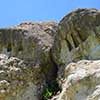Parmak Kaya near the village of Nochevo
Parmak Kaya is a thracian rock sanctuary, located on the road Plovdiv-Kardzhali, near the village of Nochevo, reg. Kardzhali. Its name comes from a large piece of rock that sticks out of it and resembles a finger.

When you reach the road sign for the village of Nochevo continue straight until you reach a fork where you have to proceed to the right. You will reach Pamuk Mahala where the road ends. There is no road signs. We left the car there and we asked two local women in which direction we should take to Parmak Kaya. From there we walked about 5 minutes to the rock sanctuary.
The cult complex consists of two cliffs, among which there is a cave, resembling womb. In the rocks are carved 30-40 trapezoidal rock niches, which are very typical for the Eastern Rhodopes. It is considered that they are about 3000 years old and there are many theories about what their purpose was. According to one theory, the urns of burnt ordinary people are stored there. Another hypothesis is that they represent the entrance of the human soul to the afterlife. What was their exact purpose – will surely remain a mystery to us.
The cave, the resembling womb, is one of several in this region. The ancients used them for temple purposes. The cave here is not big and has two branches – one is small and the other with a length of about 10 meters. Colony bats have settled there as you can see on the clip below. The smell was a little harsh for people with heightened sense of smell like me, but the subsequent walk through the mixed forest along the trail further refreshed me a lot.
See also

Medieval fortress and Monyak peak
The medieval fortress and peak Monyak (Monek) are located about 11 km from the town of Kardzhali, Bulgaria, near the village of Shiroko Pole, above the dam Studen Kladenets.
Explore
Rock-hewn churches of Ivanovo
Rock-hewn churches of Ivanovo are included in the List of World Cultural and Natural Heritage under the protection of UNESCO. They are located within the nature park "Rusenski Lom", near the town of Ruse, Bulgaria, near the village of Ivanovo. There are many small rock churches, chapels and cells in the area, which form the monastery wreath which are named "St. Archangel Michael ”.
Explore






























































Comments
Leave comment